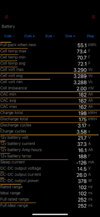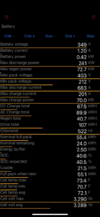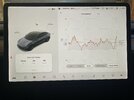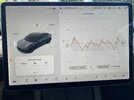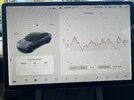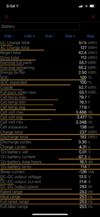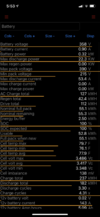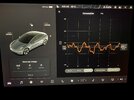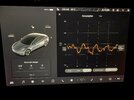Forgot to attach and I can’t edit previous post.
Thanks. NFP is 55.1kWh. Nominal Remaining is 55.2kWh.
The product is Wh/mi (recent) * Projected Range. At 100% charge this value will be the minimum of the (degradation threshold, nominal remaining).
The product is 115Wh/km*476km = 54.7kWh. This suggests to me the degradation threshold for the vehicle is about 54.7kWh (so you won't start showing loss of range until your NFP drops below this value).
And that also means that the charging constant (the actual constant value - it's a bit larger for you right now) is 54.7kWh/253rmi = 216.2Wh/rmi. This is the value that's used on the display to convert between kWh and miles added, display how many miles you are charging per hour, etc.
Right now your actual energy content per rated mile (not the displayed miles though) is 55.2kWh/253rmi = 218Wh/rmi.
However, due to the buffer, for each DISPLAYED rated mile, the energy content of those miles is currently 95.5% of that, or 208Wh/rmi (displayed). (And the plateau constant value will be 216.2Wh/rmi*0.955 = 206.5Wh/rmi (displayed). )
When they adjust the rated miles on the car, all these constant values will drop by ratio of 253/262, so:
Current, after adjustment to 262 rated miles:
210.5Wh/rmi. (For 262 rated miles at full charge, and NFP of 55.2kWh)
Final, after capacity loss and adjustment to 262 rated miles:
208.6Wh/rmi (For 262 rated miles at full charge, with NFP lower than 54.7kWh)
Again, when looking at the displayed rated miles, and calculating requirements for "parity" (rated-mile-per-mile-traveled rolloff), you will need to do 4.5% better than this (multiply values by 0.955).
Values may not be exact but they should end up pretty close with your data, since it's very good data.
Thanks for providing the values for posterity on your 2021 SR+ LFP before the update to your range!
SMT said 52.7 kWh Usable with 253 miles rated range.
Just to clarify: Usable does not include the buffer. So you have to divide 52.7kWh by the 208Wh/mi value above (the 95.5% scaled value) to get 253 rated miles.
You'll be able to do this, using a progressively smaller Wh/mi value, until you get to ~54.7kWh NFP, at which point you'll see a reduction in your rated miles at 100%, and the Wh/mi value will plateau.
(Obviously the numbers will change when the range update occurs as described above.)



